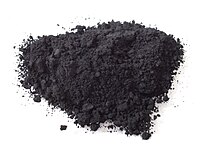
Photo from wikipedia
The focus of this study is to design new nano-modified epoxy formulations using carbon nanofillers, such as carbon nanotubes, carbon nanofibers and graphene-based nanoparticles (CpEG), that reduce the moisture content… Click to show full abstract
The focus of this study is to design new nano-modified epoxy formulations using carbon nanofillers, such as carbon nanotubes, carbon nanofibers and graphene-based nanoparticles (CpEG), that reduce the moisture content and provide additional functional performance. The chemical structure of epoxy mixture, using a non-stoichiometric amount of hardener, exhibits unique properties in regard to the water sorption for which the equilibrium concentration of water (C eq) is reduced up to a maximum of 30%. This result, which is very relevant for several industrial applications (aeronautical, shipbuilding industries, wind turbine blades, etc), is due to a strong reduction of the polar groups and/or sites responsible to bond water molecules. All nanofillers are responsible of a second phase at lower glass transition temperature (Tg). Compared with other carbon nanofillers, functionalized graphene-based nanoparticles exhibit the best performance in the multifunctionality. The lowest moisture content, the high performance in the mechanical properties, the low electrical percolation threshold (EPT) have been all ascribed to particular arrangements of the functionalized graphene sheets embedded in the polymeric matrix. Exfoliation degree and edge carboxylated groups are responsible of self-assembled architectures which entrap part of the resin fraction hindering the interaction of water molecules with the polar sites of the resin, also favouring the EPT paths and the attractive/covalent interactions with the matrix.
Journal Title: Nanotechnology
Year Published: 2017
Link to full text (if available)
Share on Social Media: Sign Up to like & get
recommendations!